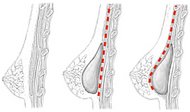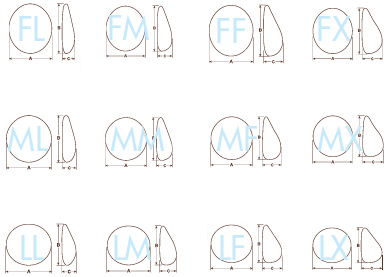Sorensen Clinic
Plastic and Reconstructive Surgery
10 Knaresborough Place
Kensington
London SW5 0TG
United Kingdom
Appointments: +44 (0) 20 7600 4444
Email: info@sorensenclinic.com
Office hours
Monday - Friday: 09.00 - 17.30

Anatomical breast implants vs. round breast implants

Placement of breast implants: the dotted red line indicates the pectoralis major muscle, breast implants can be located above the muscle, partial sub-muscular (dual-plane) or completely sub-muscular (not shown). The implant is never located within the breast gland, always below it, thus doesn't effect the functionality of the glandular tissue
Dual Plane Breast Augmentation
A modern surgical technique where the implant is placed in two anatomical planes simultaneously - partially behind the pectoralis major muscle (upper part) and partially behind the glandular tissue (lower part).
The dual plane approach optimises the relationship between implant and soft-tissue, hides the upper border of the implant and ensure long-term implant stability.
Combining the advantages from both sub-glandular and sub-muscular placement, dual plane breast augmentation provides a slight breast lift and a natural breast appearance.

When choosing breast enhancement surgery, a woman is selecting to have a breast implant for many years. This is the reason why it is important to research and to choose carefully. Breast implants come in different shapes and qualities, some with specialised purposes: round, anatomical, smooth, textured, saline, silicone-gel, projecting and non projecting etc.
This article is written to provide an overview of anatomical implants.
The choice of breast implant is the single most important non-surgeon related variable in breast enhancement surgery that determines the breast shape outcome as well as how the woman's long-term relationship with the implants evolves. Despite this, few woman actually ask for specific details relating to their breast implants or questions the method that provides the basis for their selection and placement.
The selection of breast implants starts with measurements of the chest. A standadised scientific method is used to identify and quantify variations in chest shape, breast width, breast height, position of the infra-mammary fold, breast tissue, areola position, breast ptosis (droopiness) and possible breast asymmetries. These parameters will provide the basis for discussion of options, goals and possible surgical outcomes.
A number of tools are employed to assist in this decision making (BioDynamics system), there is also a special garment which allows a woman to trial different implant shapes on her body.
Anatomical implants utilise a textured surface that allows a mild tissue-adherence, which is desirable as it ensures a secure implantation and reduces the long-term risk of capsular contraction.
Multilayered technology is used in the manufacture of the implant shell, combining materials with particular properties to allow for a flexible protective barrier with reduced silicone permeability, improved durability and less risk of rupture.
The gel is the key component of the implant as it gives the implants its form and firmness which is ultimately conveyed into breast shape. Silicone can be made in almost every form, from liquid to solid, depending on the amount of ‘cross-link’ components included in the formula. Anatomical breast implants use a firm gel (also known as cohesive gel or being ‘form-stable’). Form stability means that the gel retains its form even after being compressed, such gels provide the best possibility for shape control - and at the same time it has the firm consistency of natural breast tissue.
Round breast implants generally use soft gel technologies. The reason being that as they are uniformly round, and an aesthetically acceptable result depends on the round implants ability to adjust to the breast in order for the rounded breast borders not to become to visible. Although all silicone gels in principle are cohesive, even the softer ones, round implants don’t use firm gels and are therefore less form-stable.
Round breast implant will therefore (in our opinion) represent a compromise when it come to enhancement of breast shape, a compromise that is not required with the use of anatomical implants.
Round implants are the traditional implants that have been in clinical use since 1963. Although female breasts are not round by nature, the round implant remains the most widely used implant for breast surgery in UK. Used above the pectoral muscle without sufficient glandular-tissue cover, they will yield a characteristic rounded appearance. However, with proper placement, using a dual plane partial sub-muscular approach, round implants can provide natural-looking and satisfying results, especially on young women.
In selecting a round implant, two parameters are of importance: (1) The diameter of the implant, and (2) the projection of the implant. By adjusting these parameters the amount of volume can be increased and raised (as a dome). It is important to recognize that round implants primarily adds volume to the breast.
The shaped implant’s function is to strategically position volume where desired, and one of their main characteristics is a flatter upper breast pole and a fuller lower breast curve. An appearance that usually is associated with a youthful natural-looking female breast appearance.
As anatomical breast implants are fully customizable in shape and volume, they represent a personalised solution to provide a proportionate enhancement of the female breast. In addition to providing a aesthetic motivated fuller and firmer appearance, these implants can also be used to lift the breast, restore volume lost after breast feeding or balance asymmetries. Anatomical implants also provide possibilities to improve appearance for patients with breast-base deformities (tubular breasts), and for a wide range of reconstructive procedures following oncology surgery.
Many women may not realise that volumes (ie. implant weight) on anatomical and round implants are not identical. Among implants with corresponding width, anatomical implants will be approximately 20% lighter than round implants of the same base width. Moreover, as the implant shape is selected to provide augmentation where required, less gel is needed as compared to round implants. Anatomically breast implants convey their shape on to the breast by lifting the tissue up, rather then pushing it out.
If a larger than proportionate breast augmentation is desired, the anatomical implants will remain more in balance with the chest and shoulders than large round breast implants of the same base width.
With anatomical implants three parameters may be varied: (1) The width of the implant, (2) the height of the implant and (3) the projection of the implant. For this reason, anatomical breast implants are able to provide truly ‘three-dimensional’ breast enhancement.

Anatomical breast implants simulate the dimensions and volume distribution of the natural breast. A broad range of individual shapes offers the greatest control of cleavage and breast width, while maintaining the natural aesthetics of the upper breast pole.
Implant pocket locations used for anatomical breast implants are: (1) behind the breast’s glandular tissue and above the muscle, (2) partially behind the pectoralis muscle using a dual plane approach, and (3) totally behind the pectoralis and serratus muscle. All of these pocket placements have specific benefits and indications.
All textured breast implants integrate into their permanent position after two weeks. Before implants finally adhere, implants can rotate within their pocket. Statistically, one per cent of anatomical breast implants will rotate before they have settled. Should this occur, a minor adjustment would be required to re-position the implant.
Round silicone implants have been in use for more than 45 years and shaped cohesive-gel implants since 1993. Due to large interest worldwide, the anatomical cohesive-gel breast implant may well be one of the most studied implant devices around the world, this means that there is plenty of clinical data documenting the safety and predictable results related with these devices. Of all breast implants followed in clinical trials, anatomical cohesive-gel breast implants have the lowest complication rates of any type of breast implant, this include incidences of capsular formation, implant migration, shell failure and implant folding.
Anatomical breast implants allow for a fully customised and aesthetically pleasing solution for enhancing both breast shape and volume. Being an advanced tool for providing natural-looking, three dimensional breast augmentation, the implants solve common aesthetic concerns and specialised aesthetic requirements equally well. At the same time anatomical implants provide the best long-term performance of any implant.
Dr Sorensen's general recommendations for choosing breast implants
Round breast implants will suit
● Young women (early 20's) with firm breast tissue
● Women who desire a rounded breast shape, with a rounded upper breast curve
Anatomical breast implants will suit
● Women who desire a proportionate and natural-looking breast augmentation
● Women who are slim, or have modest breast tissue
● Women who have breastfed
● Women with breast asymmetries
● Women who desires a breast-lift simultaneously with their augmentation
Either type will suit
● Women with plenty of glandular breast tissue, who desire more volume
Anatomical implants also provide possibilities to improve appearance for patients with constricted breast-base deformities (tubular/tuberous breasts), and for reconstructive procedures following oncology surgery.